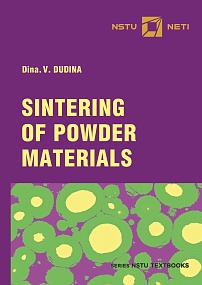This study guide corresponds to “Sintering of powder materials” course of the Master degree program at Novosibirsk State Technical University 22.04.01 – Materials Science and Technology. The guide consists of six parts and contains a brief overview of historical aspects of sintering, powder fabrication and characterization methods, powder shaping and compaction processes, and the basics of solid state and liquid phase sintering. The guide also contains a description of advanced sintering methods and sintering processes found in additive manufacturing. Classical and novel materials obtainable by sintering are described. Current trends in the development of sintering science are discussed. Each part of the guide is followed by control questions. Problems with solutions are offered to help the student solve problems encountered in real research and industrial sintering practice. Problems for self-study are also provided, many of which were designed by the author based on her own research experience. Topics for self-study are provided and can be used for students’ presentations at seminars.
DOI: 10.17212/978-5-7782-4515-0
CONTENTS
Preface ............................................................................................................ 7
Part 1. DEFINITIONS AND HISTORICAL ASPECTS. SINTERING
DRIVING FORCE .................................................................................. 9
1.1. Definitions of sintering and historical aspects ........................................ 9
1.2. Sintering driving force .......................................................................... 11
Control questions ......................................................................................... 13
Part 2. POWDER FABRICATION AND PRE-SINTERING
OPERATIONS ...................................................................................... 14
2.1. Powder fabrication and characterization ............................................... 14
2.2. Powder shaping and compaction ........................................................... 23
Control questions ......................................................................................... 28
Part 3. TYPES OF SINTERING ....................................................................... 29
3.1. Solid state sintering ............................................................................... 30
3.2. Liquid phase sintering ........................................................................... 42
3.3. Pressureless sintering and sintering under pressure .............................. 45
3.4. Sintering of powder mixtures and composite particles. Reactive
sintering ................................................................................................. 56
3.5. Computer simulation of sintering and in-situ sintering studies ............. 62
Control question ........................................................................................... 62
Part 4. ADVANCED SINTERING METHODS .............................................. 66
4.1. Resistance sintering ............................................................................... 67
4.2. Spark plasma sintering .......................................................................... 69
4.3. High-voltage consolidation ................................................................. 101
4.4. Induction sintering ............................................................................... 105
4.5. Flash sintering ..................................................................................... 106
4.6. Microwave sintering ............................................................................ 110
4.7. Sintering in additive manufacturing .................................................... 116
Control questions ....................................................................................... 123
Part 5. MATERIALS OBTAINED BY SINTERING .................................... 125
5.1. Design in powder technologies ........................................................... 125
5.2. Structural materials obtained by sintering ........................................... 127
5.3. Functional materials obtained by sintering ......................................... 130
5.3.1. Classes of functional materials obtainable by sintering ................ 130
5.3.2. Field-assisted sintering of functional materials ............................. 133
Control questions ....................................................................................... 145
Part 6. NEW RESEARCH DIRECTIONS IN SINTERING.
NOVEL MATERIALS AND MICROSTRUCTURES ....................... 148
6.1. Processing of metallic alloys by SPS .................................................. 148
6.2. Layered materials and materials with gradient structures ................... 157
6.3. Joining of materials by passing electric current .................................. 163
6.4. Porous materials by SPS ..................................................................... 171
6.5. Deposition of coatings on particle surfaces ......................................... 185
6.6. Recycling of metallic scrap using electric current treatment .............. 187
6.7. Obtaining complex shapes by SPS ...................................................... 189
6.8. Cold sintering ...................................................................................... 193
Control questions ....................................................................................... 193
Summary ......................................................................................................... 195
Problems with solutions .................................................................................. 196
Problems for self-study ................................................................................... 203
Topics for self-study ....................................................................................... 214
References ....................................................................................................... 217

